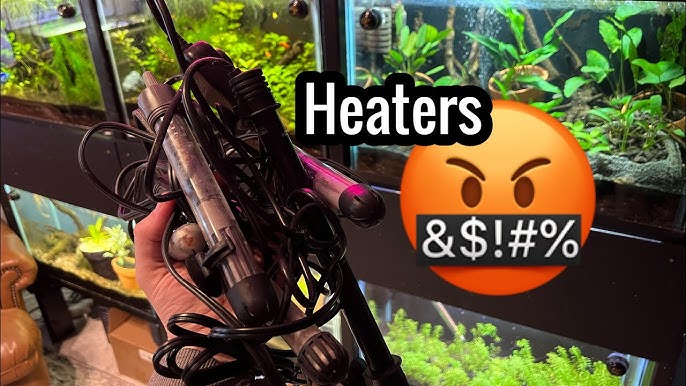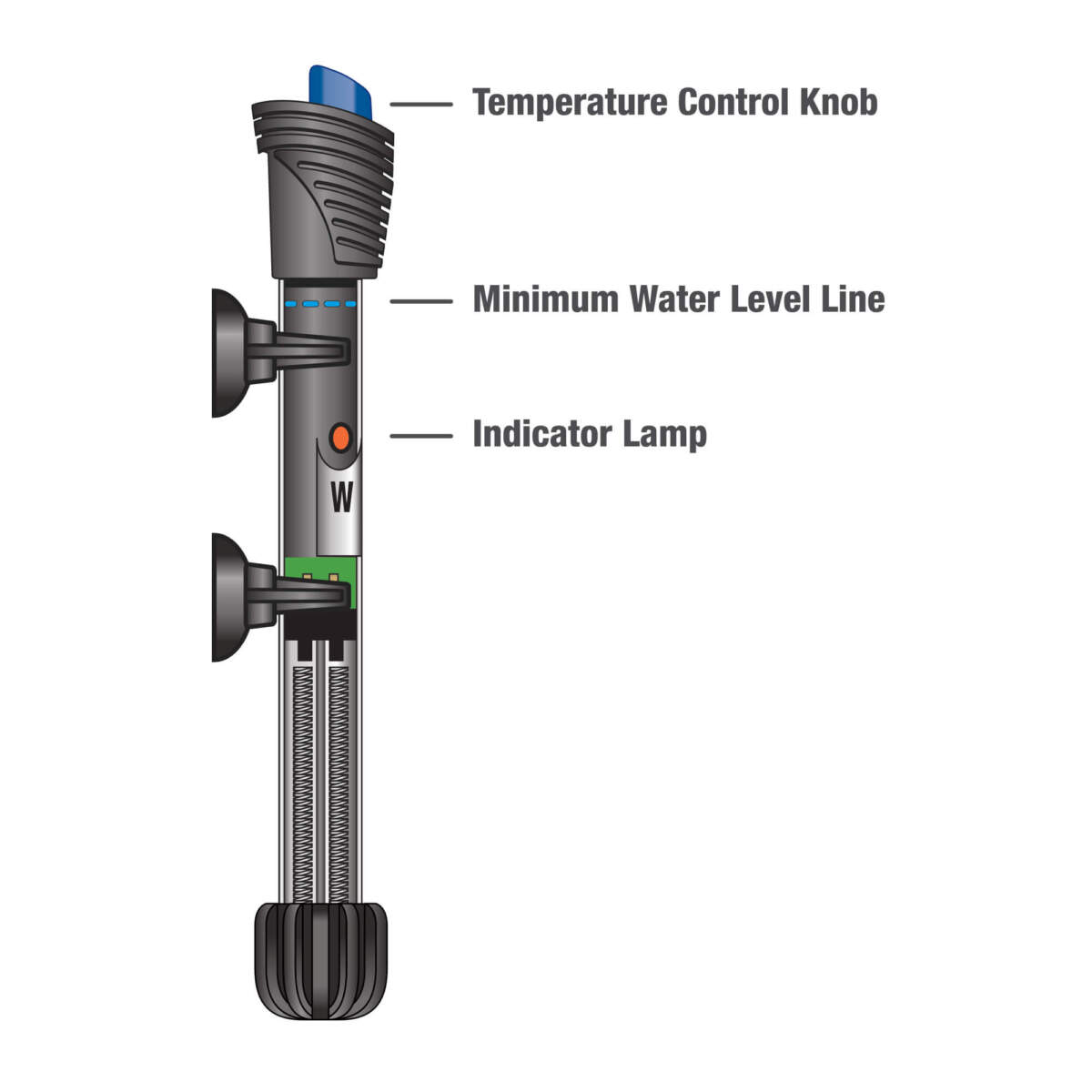Imagine walking into your living room, excited to see your vibrant aquarium, only to find your aquatic friends looking less lively than usual. You notice the water temperature is not quite right, and your heart sinks as you realize your aquarium water heater is not working.
This situation is more common than you might think, and it can leave you feeling frustrated and concerned for the well-being of your fish. But don’t worry. You’re about to discover why your aquarium heater might be malfunctioning and, more importantly, how you can fix it.
Whether you’re dealing with a faulty thermostat, a broken heating element, or even a simple electrical issue, understanding the problem is the first step to restoring the perfect habitat for your underwater companions. Keep reading to find out how you can troubleshoot and resolve the issue, ensuring your aquarium returns to its ideal, cozy environment. By the end of this article, you’ll have the knowledge and confidence to tackle any heater hiccup, securing a safe and comfortable home for your finned friends.
Page Contents
Common Causes Of Heater Failure
Aquarium water heaters often fail due to faulty thermostats, broken heating elements, or electrical issues. Regular checks can prevent these problems. Keep an eye on temperature fluctuations for early signs of malfunction.
When your aquarium water heater stops working, it can be a frustrating experience. Understanding the common causes of heater failure can help you troubleshoot and potentially fix the issue. Let’s dive into some of the most frequent problems that can occur with aquarium heaters.Electrical Issues
Electrical problems are a frequent culprit when it comes to heater malfunctions. Loose or corroded connections can disrupt the power supply, causing the heater to stop working. Have you checked the power cord for any visible damage or wear? A quick inspection can sometimes reveal issues that are easily fixed. Consider using a multimeter to test the outlet and power cord. This simple tool can help you pinpoint electrical failures. Remember, safety first—always unplug the heater before examining electrical components.Thermostat Malfunctions
The thermostat is the brain of your aquarium heater. If it fails, the heater may not maintain the correct temperature. Have you noticed inconsistent water temperatures? This could be a sign of thermostat issues. Sometimes, recalibrating the thermostat can resolve the problem. Many heaters have a manual adjustment feature. Check your heater’s manual for instructions and see if a simple reset can bring your heater back to life.Heater Element Damage
The heater element is crucial for generating warmth. If it’s damaged, your heater won’t function properly. Look for cracks or signs of wear on the heater casing—these can indicate internal damage. Consider the age of your heater, as older models are more prone to element failure. If repairs are not possible, it might be time to invest in a new heater. How often do you check your heater for visible signs of wear and tear? Troubleshooting these common issues can extend the life of your aquarium heater. Regular maintenance and careful observation can prevent small problems from becoming major headaches. Do you have any other tips for keeping your aquarium heater in top shape?
Credit: www.reddit.com
Initial Troubleshooting Steps
Facing issues with your aquarium water heater? You’re not alone. Heaters can sometimes cause problems, but there are simple solutions. Before buying a new heater, try these initial troubleshooting steps.
Checking Power Supply
First, check the power supply. Ensure the heater is plugged in securely. Next, test the outlet with another device to confirm it’s working. Power strips can fail, so plug the heater directly into the wall. If the power supply works, move to the next step.
Inspecting Heater Placement
Heater placement affects performance. Ensure it’s submerged fully. The heater should sit near a water flow source. This distributes heat evenly. Avoid placing it too close to the substrate or decorations. These can trap heat and cause damage.
Examining Indicator Lights
Indicator lights give vital clues. Check if the light is on. A working heater typically shows a solid or blinking light. No light might indicate a fault. Consult the user manual for specific light patterns.
Quick Fixes For Minor Problems
Is your aquarium water heater acting up? Minor issues can often be resolved with a few quick fixes, saving you from the hassle of expensive replacements. Addressing these common problems can make a world of difference in maintaining the perfect environment for your aquatic friends. Let’s dive into some simple solutions that you can try right now.
Resetting The Thermostat
Sometimes, all your heater needs is a reset. The thermostat can occasionally get stuck, causing erratic temperature fluctuations. You can reset it by turning the heater off for a few minutes and then back on. Check if the temperature stabilizes. If this doesn’t work, try adjusting the temperature setting slightly to see if it triggers a response. It’s a quick fix that might just do the trick!
Cleaning The Heater
Dirt and algae buildup can hinder the heater’s efficiency. A clean heater is a happy heater. Unplug your heater and remove it from the tank. Use a soft brush or cloth to gently scrub away any residue. Pay special attention to the heater’s surface and the thermostat area. Once clean, place it back in the tank and monitor the temperature. Regular cleaning can prevent issues before they start.
Tightening Loose Connections
Loose connections can disrupt the heater’s performance. Check the power cord and any other connections. Are they secure? A loose plug can lead to intermittent heating. Tighten any loose connections and ensure everything is plugged in properly. This simple step can restore your heater’s functionality and keep your tank’s temperature stable.
Have you ever experienced a heater malfunction at the worst possible time? Maybe you noticed it on a chilly morning when your fish seemed less active. Taking proactive steps like these can prevent minor issues from escalating. What other quick fixes have you tried that worked wonders? Share your insights in the comments below!

Credit: www.youtube.com
When To Replace Your Heater
Experiencing cold water in your aquarium signals a malfunctioning heater. Regularly check for any visible damage or wear. Replace it promptly to ensure a stable and healthy environment for your aquatic pets.
Aquarium water heaters are essential for maintaining the right temperature for your aquatic friends. But what happens when your heater stops working? Knowing when to replace your heater is crucial for the well-being of your fish. The signs are not always obvious, and delaying a replacement could lead to a less than ideal environment for your aquatic pets. Here’s how to know when it’s time to swap out your old heater for a new one.Signs Of Irreparable Damage
A heater that isn’t heating is an obvious red flag. But look closer. Is the casing cracked? Are there any burn marks on the unit? These are signs of irreparable damage. A cracked casing can lead to electrical issues or even an aquarium disaster. Don’t wait until it’s too late. If you spot any of these issues, it’s time to replace your heater.Safety Concerns
Safety should be your top priority. An old or malfunctioning heater can pose serious risks. Water and electricity are a dangerous mix. A faulty heater can lead to electrical shocks or fires. Have you noticed any flickering lights or unusual smells? If yes, disconnect the heater immediately. Keeping your home and your aquatic pets safe should never be compromised.Upgrading To A New Model
Technology evolves rapidly. New models are often more efficient and reliable. Have you been using the same heater for years? It might be time to upgrade. Newer models come with features like temperature displays and automatic shut-off. These can provide peace of mind and make your life easier. Consider what features would benefit you and your aquarium before making a choice. Replacing your aquarium heater isn’t just a chore—it’s a way to ensure the health and safety of your aquatic environment. By paying attention to these signs and safety concerns, you make sure your fish thrive. Is your heater showing any signs of wear? If yes, don’t hesitate to make the change. Your aquatic pets will thank you for it.Maintaining A Healthy Aquarium Environment
Aquarium water heater problems can disrupt the tank’s delicate balance. Ensure consistent temperature to keep fish healthy. Regular checks and timely repairs prevent stress and diseases in aquatic life.
Maintaining a healthy aquarium environment is crucial for the well-being of your aquatic pets. A malfunctioning water heater can disrupt this delicate balance, leading to stress and health issues for your fish. To prevent such mishaps, it’s essential to be proactive and informed about your aquarium’s needs.Regular Temperature Monitoring
Regularly checking the temperature of your aquarium is a simple yet effective way to ensure a healthy environment. Use a reliable aquarium thermometer and make it a habit to check the temperature at least once a day. This practice helps you catch any discrepancies early, allowing you to address potential issues before they become serious problems.Choosing The Right Heater
Selecting the right heater for your aquarium is key to maintaining a stable environment. Consider the size of your tank and the specific needs of your fish. A too-small heater may not effectively warm the water, while an oversized one could overheat it. Research the best types of heaters for your specific aquarium setup to ensure your fish thrive.Backup Plans For Heater Failure
Even the best equipment can fail, so having a backup plan is wise. Consider investing in a secondary heater, especially if you have a large or expensive fish collection. Alternatively, keep a few emergency heat packs handy. These packs can temporarily maintain water temperature until you replace or repair the primary heater. Have you ever thought about what you would do if your heater stopped working in the middle of the night? Planning ahead can save you a lot of stress and keep your fish safe.Preventative Measures
Keeping your aquarium heater in top condition is vital. Preventative measures ensure a stable environment for your aquatic life. Addressing issues before they occur can save you time and prevent stress for your fish. Understanding and implementing these measures can make a significant difference.
Routine Equipment Checks
Regularly inspect your aquarium heater for signs of wear. Look at the heater casing for cracks or discoloration. Test the heater’s functionality by monitoring the water temperature. Fluctuations might indicate a problem. Clean the heater regularly to prevent debris buildup. This helps maintain efficiency. A simple check can prevent major issues.
Investing In Quality Equipment
Choose a heater from reputable brands for your aquarium. Quality equipment often lasts longer and provides reliable performance. Research products thoroughly before buying. Read reviews from other aquarium owners. Ensure the heater matches your tank size and needs. This investment can prevent frequent replacements.
Using Surge Protectors
Surge protectors safeguard your heater from electrical spikes. These spikes can damage sensitive equipment. Connect your heater to a surge protector. This small device can protect against sudden power surges. Ensure the surge protector is properly rated for your heater’s wattage. This adds an extra layer of security.

Credit: www.aqueon.com
Frequently Asked Questions
What To Do When An Aquarium Heater Is Not Working?
Check power supply and connections first. Test heater in a different outlet. Inspect for visible damage or wear. Replace faulty heater promptly to maintain aquarium temperature. Consult a professional if unsure about repairs.
How To Tell If An Aquarium Heater Is Bad?
Check for fluctuating water temperature, visible damage, or an inactive indicator light. Test with a thermometer. Ensure consistent heating for optimal aquarium conditions.
What Are Common Causes Of A Water Heater Not Working?
Common causes include faulty thermostats, tripped circuit breakers, sediment buildup, pilot light issues, and broken heating elements. Regular maintenance helps prevent these problems and ensures efficient operation.
How Long Do Aquarium Water Heaters Last?
Aquarium water heaters typically last 3 to 5 years. Regular maintenance can extend their lifespan. Ensure proper installation and monitor for signs of wear. Replace heaters showing fluctuating temperatures or physical damage for optimal aquarium health. Investing in a high-quality heater can enhance longevity and performance.
Conclusion
Fixing a broken aquarium heater can seem tough. Start with simple checks. Ensure the heater is plugged in securely. Test the outlet with another device. Adjust temperature settings and monitor changes. Clean the heater regularly to prevent issues. If problems persist, consider replacing the heater.
Proper heating is vital for fish health. Don’t delay in resolving heater issues. Choose a reliable brand for peace of mind. Regular maintenance ensures a healthy aquarium environment. Keep your fish happy and safe.
